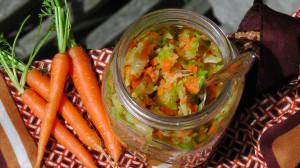We all have a vast community of bacteria that live within us, called the microbiome. The microbiome in our gut controls many of our body’s key functions and is crucial to our overall health. A balanced microbiome regulates the immune system, modulates weight and metabolism, and provides us with critical vitamins.
Your mental health, not only your physical health, is deeply influenced by the health of your gut too. A healthy microbiome supports mood and brain function. When your microbiome falls out of balance, you can become ill.
Consuming naturally fermented foods is one of the best ways to balance the microbiome in your gut. Fermented foods are natural probiotics and are rich in live bacteria that replenish the microbiome, helping it maintain the right proportion of friendly bacteria for optimal health and weight loss.
Sauerkraut is a fermented food along with Kefir, Kimchi, and Kombucha, to name a few. The name “sauerkraut” literally means sour cabbage. A process called lacto-fermentation makes sauerkraut. When the cabbage is submerged in brine, an anaerobic (without oxygen) environment is created in which glucose and other sugars in the cabbage are converted into energy and lactic acid.
How to Make Sauerkraut
Making sauerkraut is a good place to begin with when starting out with fermenting foods because you need very little ingredients or equipment. All you need is cabbage, salt and a jar.
You Will Need
- 1 medium green or red cabbage
- 2 medium carrots
- 1 1/2 tablespoons Himalayan salt
- 2 large jars
What To Do
- Remove the outer leaves of your cabbage. Put aside a couple of large leaves to use at the end.
- Slice or shred the cabbage into small pieces and grate the carrots.
- Place cabbage and carrot in a large bowl with the salt.
- Using your hands start to massage and squeeze the cabbage. Keep massaging and squeezing it. The cabbage and carrot will start to become limp and watery over time. This takes about 5-10 minutes.
- Tightly pack your shredded cabbage and carrot mixture into each jar, and compress down using your hands or a smaller jar to remove any air. Top with a cabbage leaf, tucking it down the sides of the jar. Make sure the veggies are completely covered with brine and that the brine is all the way to the top of the jar, to eliminate any trapped air.
- Put the lids on your jars loosely, as they will expand due to the gases produced in fermentation. Alternatively, you could cover with a cheesecloth and push the veges under the liquid each day to make sure they are submerged.
- Keep the jars at room temperature on your counter for 3-10 days. Sauerkraut or fermented veggies are usually done in 3 – 4 days. In the winter, they may need 7-10 days. The only way to tell when they are done is to have a taste. When you are happy with the taste, pop the jars in the fridge to slow down the fermentation. The sauerkraut will slowly mature further if you don’t eat it all before then!
- Never eat out of the jar, as you will contaminate the batch. Use a clean spoon and serve on another plate. Make sure the remaining sauerkraut is covered with liquid before replacing the lid.








